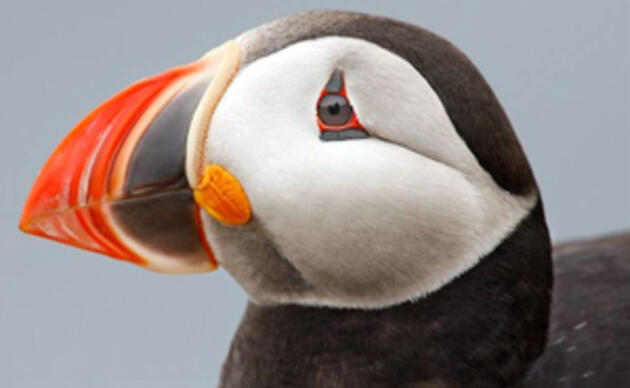Ocean Heat Wave Disrupts Puffin Nesting
Even before the 2018 summer field season started, there was ominous news from Canadian oceanographers. In April, researchers at the Bedford Institute of Oceanography in Dartmouth, Nova Scotia located unusually warm, deep water entering the Gulf of Maine. Such masses of warm water are becoming increasingly common off the Maine coast, an area historically noted for consistently cool water. Associated with melting polar ice, and warm water incursions from the Gulf Stream, these “ocean heat waves” result in a rollercoaster pattern of cool and warm summers that affect everything from plankton to puffins in the Gulf of Maine.
In 2018, puffins at Matinicus Rock and Seal Island National Wildlife Refuge began feeding their chicks small haddock rather than more typical foods, such as Atlantic herring and white hake. Fortunately, haddock was in good supply, with parents bringing home as many as ten beak-loads per day, often stuffed with half a dozen haddock. But in mid-July sea surface temperatures (SST) began to rise; by early August SST had climbed to nearly 70 degrees, setting a new record for outer Penobscot Bay. This warming led to a decline to just one to three feedings per day and some of the fish were butterfish, which are often too large for chicks to swallow.
Food for puffin chicks became scarce when forage fish moved to deeper, cooler waters, or further north. Although puffins are capable of diving more than 200 feet, they usually feed in the upper 60 feet of the water column because deep dives are energy-expensive and exhausting. As SST warmed, most chicks began losing weight and some starved. The mid-coast Maine heat wave lasted until mid-August; after that, SST dropped by about eight degrees to more typical temperatures. The cooler water in mid-August resulted in a late summer surge of white hake and smaller butterfish that arrived just in time to help the surviving puffin chicks. Puffin parents resumed more frequent feedings, with some chicks receiving ten or more feedings per day. This allowed some once-starving chicks to increase their body weight by half.
Migrate, or Stay to Feed Chicks?
Some puffin parents stayed on three weeks longer than usual, delaying migration in order to feed their chicks. This adaptability permitted many puffin parents to ultimately fledge healthy chicks.
Other studies have documented extended chick rearing for as much as 83 days for puffins—a huge contrast to the normal 38–44 days. However, chicks reared over such long periods are usually underweight, with lower survival rates than chicks that fledge in shorter periods. Longer chick rearing may also add stress to parents who have to work harder and longer to rear chicks when forage fish is scarce. The summers of 2012, 2013, and 2016 also had warmer than normal SST, and correspondingly low food deliveries for puffin chicks. The surprising thing about last summer’s observations is that food supply fluctuated greatly within the same nesting season, correlating with the ocean heat wave that moved through the Gulf of Maine.
Learn about birds and take action
Adopt-A-Puffin
Adopt now and receive: A Certificate of Adoption, A biography of "your" puffin, and The book How We Brought Puffins Back To Egg Rock by Stephen Kress.
Visitor Center
The Project Puffin Visitor Center (PPVC) is located at 311 Main Street in downtown Rockland, Maine. The center opened its doors officially on July 1, 2006.



